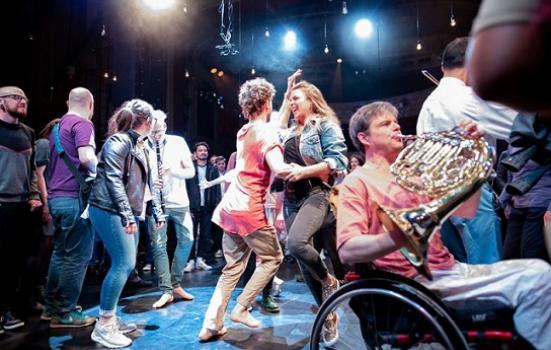Abid Hussain urged his organisation to employ more deaf and disabled people in decision-making roles.

Paul Blakemore
Arts Council England’s (ACE) record on employing disabled staff is “not good enough” and the national funder must empower more disabled decision-makers to be considered an “effective ally”, ACE’s diversity chief said this week.
“Only 6% of our staff at ACE self-define as disabled. That’s not good enough,” Abid Hussain told an audience of arts professionals in a candid speech at Unlimited: The Symposium, a two-day discussion event on disability-led arts held at London’s Unicorn Theatre.
“I want to be in an organisation disabled and deaf people want to work for. To be an effective ally we need more deaf and disabled people leading our work on policy, development, and making funding decisions.”
Hussain’s comments come as the latest figures from Taking Part, the annual Government survey of cultural and sports engagement, reveal that disabled people are more engaged with the arts than ever and that the engagement gap between disabled and non-disabled people has halved since 2005/06.
“Institutions don’t change unless the people who run them do,” he added. “If we’re not prepared to change, then we should hand over power for those who are.
“We can't keep talking about aspiration. We need to see change.”
ACE actions
According to the most recent data, 5.6% of ACE’s workforce is disabled, up from 5.1% in 2016/17. 11.5% of ACE staff identify as BME, a slight increase on 2016/17, but this proportion has been steadily falling since 2008, when it was about 15. The figures compare to a working-age population that is 16% BME and 20% disabled.
The proportion of non-white and disabled staff in National Portfolio Organisations reveals a similar lack of representation. In 2016/17 – the most recent year for which data is available – just 11% of the workforce identified as BME, and 4% identified as disabled. The figures were the same for the previous year.
ACE has introduced numerous measures to address this, ranging from updated toolkits to new funding streams. Its flagship initiative has been the development of a Creative Case for Diversity rating for each NPO, which is based on an assessment of creative programming .
But the organisation has resisted calls to make funding conditional on the diversity of an NPO’s workforce. Instead, it has said it wants objectives that are “smart and appropriate for each individual organisation” and that organisations in receipt of the largest amounts of funding must diversify their boards by 2021.
Unlimited
Unlimited: The Symposium featured talks and breakout sessions on subjects including the nature of disability arts, the challenges and opportunities presented by intersectional identities, and the potential for change.
Many speakers agreed that progress is not achieved by complaining, hoping and wishing. Instead, Rachel Coldicutt, Director of think tank Doteveryone, outlined the importance of telling effective stories to engage people in creating equality together.
She added that it was important to “put your ego aside” and work with others who may be trying to reach the same goal but doing it differently. Similarly, she said it was important to look at the need for change from multiple perspectives, as focusing on personal goals creates the risk that someone else will remain excluded once an individual’s objective is completed.
Caroline Bowditch, newly-appointed Executive Director of Access Arts Victoria in Australia, said she had learned that change must happen “from the inside”. “It can’t happen from staying in the margins,” she commented. “It has to happen from a place where you can be a decision maker. “We can have all the allies that we want, but what we actually need is accomplices.”
She later posed the provocative question of how the sector could know when such work and the push for equality “is done”.
In response, Artist Aby Watson said such a situation was unlikely as the world is constantly in flux. Hussain suggested the work would be done when there are different people in positions of power.




